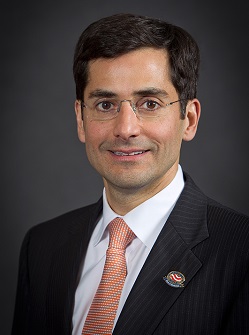RBMA 2019 PaRADigm: Take a stake in policy decisions affecting radiology
From HMOs to ACOs to the several arms of CMS’s Quality Payment Program (QPP), policymakers have been pushing healthcare providers to achieve better outcomes for less dollars—i.e., to improve value—for generations now.

Reflecting on these waves of change at RBMA PaRADigm 2019, Ezequiel “Zeke” Silva III, MD, looked even further back, to the establishment of the first colonies in North America by British companies. From there, he retraced how U.S. healthcare policymaking evolved into the complex web of forces that drive healthcare economics today. And he urged attendees to consider where things may be headed next for radiology in particular.
“Only time will tell, but I think clinically integrated networks may be the one [model] that allows us [radiology practices] to maintain our independence,” said Silva, who practices in Texas and serves as chair of the ACR’s commission on economics. “It sort of eases some of the antitrust laws, eases some of the anti-kickback laws and arguably eases some self-referral laws while allowing us to kind of integrate.”
The fly in the ointment is uncertainty. Noting the lack of experience most have with alternative payment models, Silva suggested the entire QPP process has advanced more slowly than expected for most specialists, radiologists included.
“There just aren’t that many options for us” in ACOs and such, he said. “But I have some good news. We don’t need to worry about it, because the machines are coming and they’re going to figure it all out.”
AI’s silver lining playbook
When the buzz subsided after he delivered that line, Silva explained that digital medicine is his new academic policy interest.
“How are we going to craft policy in a way that allows these technologies to evolve—but allows them to evolve carefully and responsibly?” he asked. “How do we as business leaders and business managers think about the evolution of this technology and how it might affect us?”
AI isn’t really anything new, Silva pointed out, as it’s been around since the 1950s. What’s new is the endlessly expansive capacity of today’s computing power and the massive scale of the data stores.
“Here’s where it becomes relevant for us,” Silva said. “It has the ability to automate many tasks that require human input and experience.”
However, this should be cause not for concern but for expectation.
Using the example of ATMs leading to more jobs for bank tellers, Silva suggested that line of work has become more satisfying. “It’s no longer transactional—it’s relational,” he said. “The tellers are interacting more with customers. Tellers’ jobs have changed, and in many cases they’ve changed for the better.”
What are radiology business mangers to draw from this example?
“As these technologies evolve, our job descriptions—and those of the people who report to us and to whom we report—are potentially going to change,” Silva said. “Our job performance may be judged more subjectively as our jobs become more relational.”
Take charge of change
Silva next asked attendees to consider the work of Paul Romer, the American economist who won a 2018 Nobel Prize for integrating technological innovations into long-run macroeconomic analysis.
Much of Romer’s thought can be whittled down to a conceptual battle between blind optimism and conditional optimism. Blind optimism, Silva said, is doing nothing to prepare for retirement except hoping for the best and waiting to see what happens when you get there.
By contrast, conditional optimism is saving some, investing some and more or less knowing what to expect at retirement.
“It’s such a commonsense thing,” Silva said. “Back in the late 19th century, if you were a farmer and saw a machine that could do what you’d been doing manually for the last 20 years, you got scared. So what do we do today? We need to change, we need to train and we need to adapt.”
When the U.S. economy was agrarian, it was neither uncommon nor necessarily undesirable to lack a high school diploma. Today, with “this whole AI thing” on the horizon, many if not most people feel they have some stake in where technology takes things from here.
“If you understand history and you understand the present—and you want to understand how to evaluate public policy—what do you do to prepare for the next chapter in the evolution of the economy?” Silva said. “I’m not exactly sure, but I think we can safely say it’s in education, training, involvement and greater organizational awareness. It’s in what we’re doing here today on a Tuesday morning.”
“Here’s what we cannot do,” Silva continued. “We cannot say, ‘You know, it worked out in the mid-19th century and it’s going to work out today.’ We cannot have blind optimism. It’s not sufficient. The machines are coming, and they’re coming on quickly. We need to make sure that what the machines do for us is augment what we do for our patients and our practices.”
Make friends and influence policy
Silva closed by looking back a few years to when CMS, acting on recommendations from the American Medical Association’s Relativity Assessment Work Group, was clamping down on RVUs that represented potentially mis-valued medical procedures.
Several academic physicians approached him in his role as chair of ACR’s economics commission and said they needed a new billing code for pelvis CT without contrast for pregnant women who have had abnormal ultrasounds.
“Our doctors are spending a lot of time with expectant mothers,” the physicians told Silva. “These women are nervous because they had an abnormal ultrasound. We need to do this.”
“My first reaction," Silva said, "was to think, ‘Are you kidding me? We’re getting killed with the CPT editorial panel. My motto is, no new codes.’”
Silva said he’d almost started to speak those very words when he had a change of heart.
“I thought, You know what? Let’s be brave here. Let’s think about what is going through the mind of that expectant mother who just had an abnormal ultrasound and wants to know the future of the baby she is carrying.”
He looked at the group of physicians before him and said: “Let’s do it. Let’s gather the literature, let’s get the clinical experts.”
Today, Silva pointed out, when expectant mothers go to the hospital, they don’t have to worry about whether their test is going to be covered.
And the professionals who are doing that test don’t have to worry about not getting paid.
“We enabled them to do the right thing,” he said. “That’s the nature of conditional optimism. That’s the nature of why we are here.”

